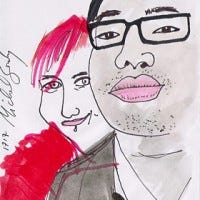Apotheon makes ancient art work in a modern game
Apotheon looks nothing like the last game independent developer Alientrap put out, Capsized -- that title inhabited a verdant alien world, lush with detailed hand-drawn illustrations of the planet's exotic flora.

Apotheon looks nothing like the last game independent developer Alientrap put out, Capsized -- that title inhabited a verdant alien world, lush with detailed hand-drawn illustrations of the planet's exotic flora. This newest project more resembles the rash of silhouetted sidescrollers that have popped up in recent years, like Limbo, Insanely Twisted Shadow Planet, and Outland. But Apotheon stands out from that style by adopting an aesthetic that's hardly been explored in games, the "Black Figure" paintings that adorn ancient Greek pottery.  It's a striking look the Canadian studio might have never settled on if the team stayed with the project's initial concept: a cyberpunk, sci-fi-themed open-world game with some mythological trappings. Apotheon started as "space Greek mythology" before the studio dropped the "space" part and realized classical mythology alone is a great source for stories that translates well to video games, which the God of War series can attest to. "The Black Figure pottery art style seemed like a no-brainer after that," Alientrap artist and co-designer Jesse McGibney tells Gamasutra. "It's simple to animate, bold and easy to read, transitions great into a 2D platformer perspective, and perfectly meshes with the narrative and theme. We were honestly surprised that hardly any games have used this style before." When you think about it, there are plenty of ancient art styles that have yet to be explored in video games. "You could flip to a random page in any art history book and find a goldmine of inspiration to draw on -- Egyptian hieroglyphics, Medieval tapestry, prehistoric cave paintings, Native American carvings," says the artist. "Heck, I would love to see a 3D game using crazy multi-perspective cubist Picasso paintings."
It's a striking look the Canadian studio might have never settled on if the team stayed with the project's initial concept: a cyberpunk, sci-fi-themed open-world game with some mythological trappings. Apotheon started as "space Greek mythology" before the studio dropped the "space" part and realized classical mythology alone is a great source for stories that translates well to video games, which the God of War series can attest to. "The Black Figure pottery art style seemed like a no-brainer after that," Alientrap artist and co-designer Jesse McGibney tells Gamasutra. "It's simple to animate, bold and easy to read, transitions great into a 2D platformer perspective, and perfectly meshes with the narrative and theme. We were honestly surprised that hardly any games have used this style before." When you think about it, there are plenty of ancient art styles that have yet to be explored in video games. "You could flip to a random page in any art history book and find a goldmine of inspiration to draw on -- Egyptian hieroglyphics, Medieval tapestry, prehistoric cave paintings, Native American carvings," says the artist. "Heck, I would love to see a 3D game using crazy multi-perspective cubist Picasso paintings."
The limitations of an ancient art style
"Pretty early on in concepting we realized that a totally literal adaptation of Black Figure art wouldn't work very well," McGibney admits. Most of the art in Black Figure paintings are character-centric, focusing heavily on the people and gods in the stories they're portraying, with little environmental representation beyond furniture or plants. "Obviously, a big part of an open world game is the environments, so we had to expand the style to show buildings, caves, forests, and many other locations that are totally absent in the source material. We're trying to create a unified language through the use of patterns and geometric shapes that are common throughout all the elements," he explains. Something else the team had to contend with is that the art on ancient Greek pottery tended to be very flat, with no backgrounds or overlapping elements, which doesn't make for visually exciting or readable environments in a video game.  The artist explains, "In order to make it work in the game world, things in the background are faded out and there are parallax layers further back. If we didn't do these things, the game world would be extremely sparse and boring. The background of Black Figure pottery is just... red."
The artist explains, "In order to make it work in the game world, things in the background are faded out and there are parallax layers further back. If we didn't do these things, the game world would be extremely sparse and boring. The background of Black Figure pottery is just... red."
Beyond black and red
Another problem with the art style is that Black Figure paintings typically have just two colors, black and red (though sometimes accompanied by white and darker red embellishments) -- a limited color palette that doesn't give video game artists much to work with. To create more distinction between environments and their tone, Alientrap ended up introducing alternative palettes and lots of colored lighting to break up the monochrome. The default palette -- red, orange, and yellow -- for example, is used for outdoors and cities, communicating bright and warm environments. Apotheon's forested or wild areas use green, while cooler sections (e.g. underground areas) are presented in blue. "Player communication is also very important, and it's really hard to do that with only one color," McGibney adds. "If all the characters were black, all the items were black, all the environmental elements were black, it would be very difficult to tell what was important and what wasn't. "We added splashes of color to draw the player's eye and let them know what they're seeing at a glance. Enemies all have red in them, the player is green, health items are bright red, money is yellow, etc. The Black Figure style is a great starting point, but we're trying to be flexible with it where the gameplay experience is concerned."
Togas and animation
Animating an art style that's a couple of millenia old and was never intended for movement was actually pretty straightforward for Alientrap, considering. McGibney used a community-developed skeletal animation editor, and set up the game's characters and animals like paper puppets, with parts hinging on their joints. He points out, "Most of the characters in the pottery are from a profile view, and occasionally straight on (no one had really figured out that whole perspective thing yet), so the movements are a pretty literal interpretation of the source material. Lots of guys running sideways on those pots."  But there were some challenges, the biggest of which was animating characters' clothing -- McGibney notes that many ancient Greeks loved wearing togas and long flowy capes, both potentially difficult to translate convincingly on an animated character. "Some characters have big baggy 'skirts' built into their animation skeleton that can make convincing dresses or robes, but I still have to make a few design concessions when making new characters," he says. "Luckily, as much as they liked their togas, the Greeks seemed to like being butt-naked even more."
But there were some challenges, the biggest of which was animating characters' clothing -- McGibney notes that many ancient Greeks loved wearing togas and long flowy capes, both potentially difficult to translate convincingly on an animated character. "Some characters have big baggy 'skirts' built into their animation skeleton that can make convincing dresses or robes, but I still have to make a few design concessions when making new characters," he says. "Luckily, as much as they liked their togas, the Greeks seemed to like being butt-naked even more."
About the Author(s)
You May Also Like







.jpeg?width=700&auto=webp&quality=80&disable=upscale)








